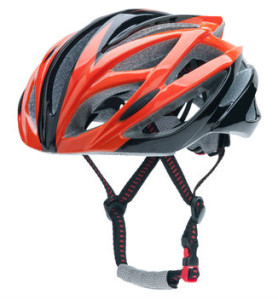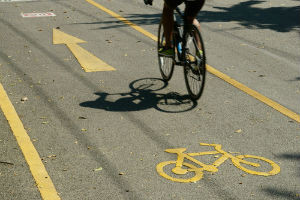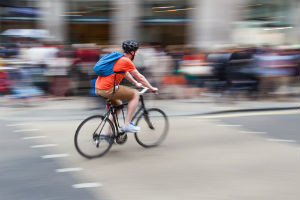Cycling is a popular form of recreation and transportation in Boston. According to the Official Website of the City of Boston – Bike Statistics, bike ridership is increasing. Over a two-year period, ridership in the city increased by 122 percent. A point of concern, however, is that the bicyclist crash rate for Boston is one crash per every 1,030 miles traveled, and that only 72 percent of cyclists report wearing a helmet.
When riding bicycle around cars, a bicycle accident causing a serious injury is a very real possibility.. If you are a bicyclist in Boston, here are five tips for cycling safety that can reduce your risk of a bicycle accident, or reduce your risk of severe injury if a crash does occur.
-
Wear Your Helmet
 As a cyclist, the single most important thing that you can do to protect yourself while riding is to wear a helmet. Helmets.org reports that helmets provide a 66 percent to 88 percent reduction in the risk of head, brain, and severe brain injury for all age groups. Because head injuries are the primary cause of death for cyclists, you can reduce your risk of mortality if you are involved in a crash as a bicyclist by wearing a helmet.
As a cyclist, the single most important thing that you can do to protect yourself while riding is to wear a helmet. Helmets.org reports that helmets provide a 66 percent to 88 percent reduction in the risk of head, brain, and severe brain injury for all age groups. Because head injuries are the primary cause of death for cyclists, you can reduce your risk of mortality if you are involved in a crash as a bicyclist by wearing a helmet.The state of Massachusetts has a mandatory helmet law for all bicyclists who are 16 years of age or younger, but does not require adult cyclists to wear a helmet (see: Massachusetts General Laws Section 11B). There is no law regarding helmet use that is implemented by the city of Boston. However, regardless of the law, the use of a helmet may save your life or prevent a disabling head injury.
-
Follow Bicycle Traffic Laws
 The second thing that you can do to protect yourself and reduce your risk of being involved in a bike-car crash is to be sure to follow all bicycle traffic laws. Found in the same section of Massachusetts code cited above, some of these laws include:
The second thing that you can do to protect yourself and reduce your risk of being involved in a bike-car crash is to be sure to follow all bicycle traffic laws. Found in the same section of Massachusetts code cited above, some of these laws include:- Never ride more than two bicyclists abreast in a single lane;
- Never transport a child under the age of four on a bike unless the child is in an approved baby seat;
- Always keep at least one hand on the handlebar at all times;
- Do not carry any packages or parcels that obstruct operation of your bike;
- Be sure to maintain brakes that allow you to stop efficiently; and
- Use a bicycle light on the front and rear of the bicycle during dawn, dusk, and dark.
Be sure to refrain from riding in prohibited areas, and to follow other laws that apply to vehicles as well, such as yielding and stopping at stop signs and traffic lights.
-
Use Hand Signals to Inform Drivers of Your Actions
Because bikes do not have traditional signaling devices, it can be difficult for the driver of a car to predict what a bicyclist is going to do. To help mitigate this problem, it is important that you use hand signals to make your intended actions known. If you do not know hand signals, see below:
- Right turn. To signify that you are planning on making a turn to the right, extend your left arm with your arm bent at a 90 degree angle, hand facing up towards the sky.
- Left turn. To signal that you will be turning left, simply extend your left arm straight out, parallel to the ground.
- Slow down/stop. If you are slowing down or planning to stop, extend your left arm, with your elbow bend at a 90 degree angle with your hand facing downwards toward the ground.
All bike signals are made with the left arm so that cars to the left of you can see.
-
Choose to Ride in Low-Traffic Areas
In some cases, riding on the road may be unavoidable. However, if there is a bike path available, or a route to get to your destination that is less trafficked, choose it. You put yourself at a greater risk of being involved in an accident when you ride on the road with cars in highly trafficked areas.
Luckily, the city of Boston has some great bike paths. See this Greater City of Boston Cycling and Walking Map to pick a route that works for you!
-
Ride Defensively
 Whether you are driving in your car or riding on your bike, you should always practice defensive operating. This means being on the lookout for other drivers around you who might not be operating their vehicles as safely as they should.
Whether you are driving in your car or riding on your bike, you should always practice defensive operating. This means being on the lookout for other drivers around you who might not be operating their vehicles as safely as they should.As a bicyclist, you are incredibly vulnerable. Even a small accident could result in catastrophic damages. As such, you need to stay aware of all risks, and be on the alert for unsafe drivers.
Even when you have the right of way, such as when going through an intersection or making a left-hand turn, do not assume that other drivers will stop. Making an assumption like this can be deadly; often times, drivers are not paying attention or simply do not see you. In other instances, a driver may incorrectly estimate their distance from you, and continue traveling at the same speed, resulting in a tragic accident.
Boston Bicycle Accident Attorneys Ready to Serve You
If you are a cyclist, bike riding safety should be a priority to reduce the risk of bicycle accidents. Unfortunately, even when you have taken all the precautions that you can, including wearing a helmet, following bike traffic laws, using hand signals, riding in safe areas, and riding defensively, a bike accident can still happen. In the blink of an eye, the actions of a negligent driver can change your life.
If you are involved in a bicycle accident, the Boston bicycle accident lawyers at Michael Kelly Injury Lawyers have experience handling personal injury claims and can represent you. Not only will we work with you to discover who was at fault for the accident, but we will also fight for a settlement that fully covers the injuries and losses that you have suffered. Before attempting to handle a claim after a bike crash on your own, contact us to schedule a free consultation with our attorneys today to learn more about how we can help.


 As a cyclist, the single most important thing that you can do to protect yourself while riding is to wear a helmet.
As a cyclist, the single most important thing that you can do to protect yourself while riding is to wear a helmet.  The second thing that you can do to protect yourself and reduce your risk of being involved in a bike-car crash is to be sure to follow all bicycle traffic laws. Found in the same section of Massachusetts code cited above, some of these laws include:
The second thing that you can do to protect yourself and reduce your risk of being involved in a bike-car crash is to be sure to follow all bicycle traffic laws. Found in the same section of Massachusetts code cited above, some of these laws include: Whether you are driving in your car or riding on your bike, you should always practice defensive operating. This means being on the lookout for other drivers around you who might not be operating their vehicles as safely as they should.
Whether you are driving in your car or riding on your bike, you should always practice defensive operating. This means being on the lookout for other drivers around you who might not be operating their vehicles as safely as they should.